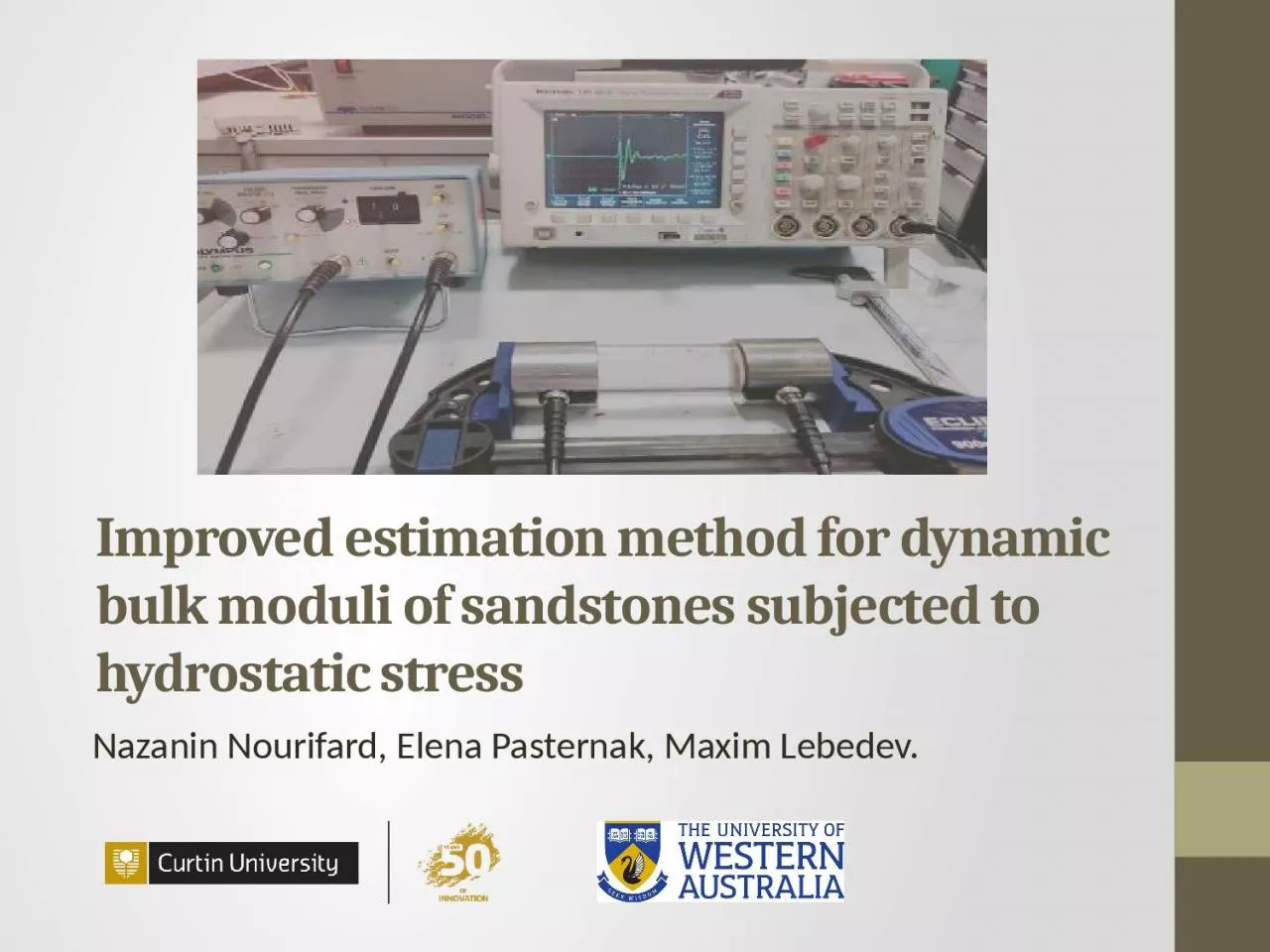

Nazanin Nourifard Elena Pasternak Maxim Lebedev Significance Static moduli of rocks are usually different from the corresponding dynamic moduli The simultaneous measurement of static and dynamic bulk moduli is rarely reported in ID: 1030761
Download Presentation The PPT/PDF document "Improved estimation method for dynamic b..." is the property of its rightful owner. Permission is granted to download and print the materials on this web site for personal, non-commercial use only, and to display it on your personal computer provided you do not modify the materials and that you retain all copyright notices contained in the materials. By downloading content from our website, you accept the terms of this agreement.
1. Improved estimation method for dynamic bulk moduli of sandstones subjected to hydrostatic stressNazanin Nourifard, Elena Pasternak, Maxim Lebedev.
2. SignificanceStatic moduli of rocks are usually different from the corresponding dynamic moduli.The simultaneous measurement of static and dynamic bulk moduli is rarely reported in literature due to difficult nature of conducting a valid test on soft rocks (sandstones). The dynamic elastic moduli method is cost efficient, non-destructive and fast to perform. High precision dynamic measurements provides useful tools for analyses and prediction of rock behaviour.Modification of this method by knowing the ultrasonic system itself.2Same sampleSame cycleSame orientation
3. Potential reasons for the difference between static and dynamic moduli (Fjaer2019)3How about accurate calculation of dynamic moduli?How about system calibration?
4. Reducing the unknowns for this experimentWe designed an experiment to isolate the potential reasons for the difference between static and dynamic moduli + accurate calculation of the dynamic moduli.4Berea sandstonesDry conditionHydrostatic stressAccurate calculation of dynamic moduli
5. 5Experimental set-up1) Oscilloscope, 2) pulser (attached to transducers at top an dbottom of the sample inside the cell), 3) Hook’s cell, 4) pumps, and 5) voltmeters (Nourifard 2019).
6.
7. 7Static and dynamic Bulk moduli as a function of hydrostatic stress for five tested sandstones (Bandara gray, Castlegate, Sister gray, Upper gray) and PMMA.
8. The plot of Vp/Vs ratio in pre- and post-stressed conditions for all the tested samples outside the stress cell.8P-and S-wave velocities measured before, immediately after, 20 days after and 60 days after loading cycles to study the effect of the relaxation of stress on velocities (another plus for dynamic method)
9. The estimated UCS by empirical equations in table compared to experimental dynamic UCS measured in the lab (illustrated in lines).Eq.ReferenceRelationshipR2Rock formation18Kahraman (2001)UCS=9.95Vp1.21.83Sandstone and limestone19Kilic and Teymen (2008)UCS=2.304Vp2.4315.94All types20Sharma and Singh (2008)UCS=0.0642Vp-117.990.9All types21Mishra and Basu (2013) UCS=0.05Vp-126.4.82Sandstone22Minaeian and Ahangari (2013) UCS=0.005Vp.94Weak rocks23Khandelwal (2013)UCS=0.033Vp-34.83.87All typesStrength Analogues (UCS)9
10. ConclusionSimultaneous results show that the dynamic Bulk modulus is higher than the static Bulk modulus for sandstones from 5% to 40%, which is in agreement with hard rocks results.Our direct measurement for both P- and S-waves by P and S wave transducers shows that the rough estimation of S-wave from its P-wave is not accurate, and the Vp/Vs ratio does not obey the classic ratio of 1.5 (especially for porous materials). By applying the accurate P-wave velocity to existing empirical equations, designed for a wide range of the rocks, the UCS value can be accurately estimated, which shows the importance of correct picking of the first arrivals.Consistency of dynamic data (pre-post loading) greatly expands the understanding of the process of changing the magnitude of elastic modules. 10
11. AuthorsTitlePublicationYearNourifard, N., Pasternak, E., Lebedev, M. “Simultaneous experimental study of dynamic and static Young’s moduli in sandstones” Exploration Geophysics2021Nourifard, N., Lebedev, M. “Bulk moduli of sandstones subjected to isotropic stress” Applied geophysics2021Nourifard, N., Pervukhinab, M., Urosevica, M., Lebedev, M. “The effects of stress and fluid on the anisotropy of reservoir rock: case study of a sandstone from the Harvey 3 CCS site, Western Australia” Exploration Geophysics2020Nourifard, N.“Effect of stress magnitude and stress rate on elastic properties of the rocks “PhD thesis2019Nourifard, N., Mashinskii, E.I., Lebedev, M. “The effect of wave amplitude on S-wave velocity in porous media: An experimental study by Laser Doppler Interferometry”Exploration Geophysics 2019Yurikov, A., Nourifard, N., Pervukhina, M., and Lebedev, M. “Laboratory ultrasonic measurements: Shear transducers for compressional waves” Leading Edge Quarterly2019Nourifard, N., Lebedev, M. “Effect of strain amplitude produced by ultrasonic wave on its velocity”Geophysical Prospecting 2018More references on this topic